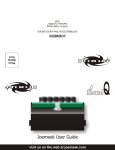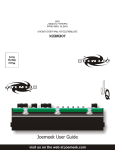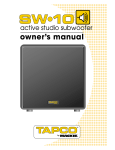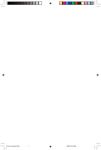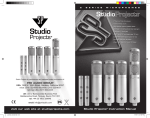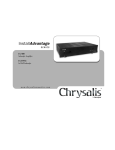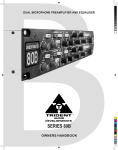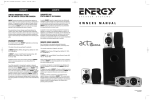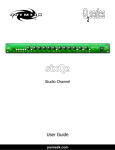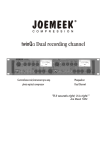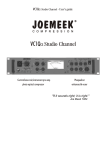Download Joemeek User Guide
Transcript
1845 W. 169th Street Gardena, CA 90247 USA DISTRIBUTED BY PMI AUDIO GROUP JOEMEEK Place Stamp Here TM mc2 TM 16 14 12 10 PEAK 8 6 4 2 STEREO OPTICAL COMPRESSOR 0 2 mc +2 +4 -2 0 -4 -10 +8 +4 -4 3:1 10 0.3 5 +9 +8 5:1 2:1 1 50 -15 +5 +12 +3 VU -30 -2 -25 +16 dB +15 INPUT GAIN +oo dBu -20 COMPRESS 1:1 10:1 SLOPE 1 ms 100 ATTACK 0.1 sec 3 RELEASE S +2 -4 -20 -40 2 -6 0 +4 +8 +12 -4 ON -24 -15 -9 GR +4 -6 +6 -8 0 dB +20 MAKE UP GAIN -10 COMP dBu -50 GR HOLD Joemeek User Guide visit us on the web at joemeek.com +8 M ON W STEREO WIDTH ON TM Joemeek is manufactured and marketed under the direction of: PMI AUDIO GROUP USA: 1845 W. 169th Street Gardena, CA 90247 toll free: 877-563-6335 fax: 310-323-0900 email: [email protected] UK: Unit 4 Minerva Court Woodland Industrial Estate Torquay, TQ2 7BD tel: +44 (0)1803-612700 fax: +44 (0)1803-612009 email: [email protected] Written by Allan Bradford, MSc 4 Important Safety Information CAUTION CAUTION: TO REDUCE THE RISK OF ELECTRIC SHOCK, DO NOT REMOVE COVER. NO USER-SERVICEABLE PARTS INSIDE. REFER SERVICING TO QUALIFIED SERVICE PERSONNEL. The lightning flash with arrowhead symbol, within equilateral triangle, is intended to alert the user to the presence of uninsulated “dangerous voltage” within the product’s enclosure that may be of sufficient magnitude to constitute a risk of electric shock to persons. The exclamation point within an equilateral triangle is intended to alert the user to the presence of important operating and maintenance (servicing) instructions in the literature accompanying the appliance. WARNING: TO AVOID FIRE OR ELECTRIC SHOCK HAZARD, DO NOT EXPOSE THIS APPARATUS TO WATER, RAIN OR MOISTURE. This appliance has a serial number located on the rear panel. Please record the model number and serial number and retain them for your records. Model number Serial number NOTE — This apparatus does not exceed the Class A/Class B (whichever is applicable) limits for radio noise emissions from digital apparatus as set out in the radio interference regulations of the Canadian Department of Communications. . ATTENTION — Le présent appareil numérique n’émet pas de bruits radioélectriques dépassant las limites applicables aux appareils numériques de class A/de class B (selon le cas) prescrites dans le réglement sur le brouillage radioélectrique édicté par les ministere des communications du Canada. These limits are designed to provide reasonable protection against harmful interference in a commercial/residential installation respectively. This equipment generates, uses, and can radiate radio frequency energy and, if not installed and used in accordance with the instruction manual, may cause harmful interference to radio communications. There is no guarantee that interference will not occur in a particular installation. If this equipment does cause interference to radio or television equipment reception, which can be determined by turning the equipment off and on, the user is encouraged to try to correct the interference by any combination of the following measures: (1) Relocate or reorient the receiving antenna (2) Increase the separation between the equipment and the receiver (3) Plug the equipment into an outlet on a circuit different from that to which the receiver is connected (4) Consult your dealer or experienced radio/television technician for additional assistance. CAUTION — Changes or modifications to this equipment not expressly approved by the party responsible for compliance could void the user's authority to operate this equipment. Important Safety Instructions 1. Read these instructions. 2. Keep these instructions. 3. Heed all warnings. 4. Follow all instructions. 5. Do not use this apparatus near water. Do not expose to drips or splashes. Do not place any objects filled with liquids, such as vases, on the apparatus. 6. Clean only with dry cloth. 7. Do not block any ventilation openings. Do not install this apparatus in a confined space such as a book case or similar unit. Install only in racks designed for the purpose and in accordance with manufacturers’ instructions. 8. Do not install near any heat sources such as radiators, heat registers, stoves, or other apparatus (including amplifiers) that produce heat. 9. Do not defeat the safety purpose of the polarized or grounding-type plug. A polarized plug has two blades with one wider than the other. A grounding-type plug has two blades and a third grounding prong. The wide blade or the third prong are provided for your safety. If the provided plug does not fit into your outlet, consult an electrician for replacement of the obsolete outlet. 10. Protect the power cord from being walked on or pinched particularly at plugs, convenience receptacles, and the point where they exit from the apparatus. 11. Only use attachments and accessories specified by the _ manufacturer. 5 12. Use only with a cart, stand, tripod, bracket, or table specified by the manufacturer, or sold with the apparatus. When a cart is used, use caution when moving the cart/apparatus combination to avoid injury from tip-over. 13. Unplug this apparatus during lightning storms or when unused for long periods of time. 14. Refer all servicing to qualified service personnel. Servicing is required when the apparatus has been damaged in any way, such as power-supply cord or plug is damaged, liquid has been spilled or objects have fallen into the apparatus, the apparatus has been exposed to rain or moisture, does not operate normally, or has been dropped. 15. Apparatus designed with Class-I construction must be connected to a mains socket outlet with a protective earthing connection (the third grounding prong). 16. This apparatus may be equipped with a single-pole, rockerstyle AC mains power switch. If so this switch is located on the front panel and should remain readily accessible to the user. 17. The manufacturer reserves the right to change the technical specification of the product without prior notice. 6 Statement of RoHS Compliance PMI Audio Group manufactures complete electronic products which are covered by the European Union’s “Removal of Hazardous Substances” directive 2002/95/EC (RoHS). This directive seeks to eliminate toxic substances from the manufacturing process, such that when equipment is disposed of at the end of its life cycle, the materials it contains do not contaminate the environment and pose health risks. Banned substances are lead, mercury, cadmium, hexavalent chromium, polybrominated biphenyls (PBB) and polybrominated diphenyl ethers (PBDE). Lead is used together with tin in solder connections to reduce the melting point of solder. Lead-free solder requires higher soldering temperatures which in turn places greater thermal stress on components. RoHS COMPLIANT Pb Statement of WEEE Policy PMI Audio Group manufactures many complete electronic products which are covered by the European Union’s “Waste Electric and Electronic Equipment” directive 2002/96/EC (WEEE). This directive seeks to ensure that waste electric and electronic equipment is disposed of in an environmentally responsible manner, at the end of its life cycle. PMI Audio Group takes seriously its obligations under this directive to take back WEEE-affected products and, from 13th August 2005, will mark all such products with the crossed-out wheeled bin symbol. PMI Audio Group takes seriously its obligations under the RoHS directive and insists that its factories use only components that are certified RoHS compliant, as well as leadfree solder. In a very few cases the necessary components may not yet be available to the world market but we work continuously to eliminate any such exceptions at the earliest opportunity. Our printed Circuit Boards (PCB’s) and all soldered joints have been lead-free since 2005. Business to Business products: PMI Audio Group will costneutrally take back WEEE-affected electric and electronic equipment in this category, from 1st January 2006. PMI Audio Group will work with disposal and recycling partners working within the EU. The waste electric and electronic equipment can then be turned over to a disposal and recycling companies in the countries concerned. Business to Customer products: emerging electric and electronic equipment will be disposed of by local authorities' collection systems. Dual Use products: this equipment will be disposed of by local authorities' collection systems. Contents JOEMEEK reborn – the legend grows mc2 Controls at a Glance...............................................8 & 9 The Next Generation of Joemeek studio processors represents a quantum leap in the history of the Joemeek legend. Long regarded for its "Big Sound", the original Joemeek gear was both revered and reviled for its somewhat "quirky" nature. Now we have taken the best of what made the Joemeek products sound great, refined it, distilled it, added to it and repackaged it. Overview...........................................................................10 Preamplifier........................................................................10 Insert Point .........................................................................10 VU Meter.............................................................................10 Compressor........................................................................11 GR Meter............................................................................13 GR Hold..............................................................................13 Stereo Width.......................................................................13 Outputs...............................................................................13 Using the mc2....................................................................14 Getting Connected...............................................................14 Using the Preamp................................................................14 Using the Compressor.........................................................14 Using the GR Hold...............................................................15 Using the Stereo Width.........................................................15 Using the insert Point...........................................................15 Troubleshooting................................................................16 Technical Specification.....................................................17 7 Properly and robustly engineered for predictable, controllable performance, the new range retains the famous Joemeek sound, with its wide, flat frequency response extending from subsonic to ultrasonic. It also uses genuinely low noise circuitry, with lots of headroom (immunity to overload). Accurate calibration and metering, together with clear panel labelling, give you complete confidence in what's going on. While some equipment pays lip-service to quality and "professional rules" but fails to deliver, the Next Generation Joemeek products are founded on good solid electronic and audio engineering, and withstand direct comparison with the very best names in mixers and outboard gear. The Joemeek range provides everything you need to get your performance onto tape/disc. About the Designer The Next Generation of Joemeek has been completely re-engineered by renowned audio electronics consultant Allan Bradford. With his background in physics and 30 years experience with the design of instruments, mixers, processors and amplifiers, Allan's unique range of expertise ensures that Joemeek remains at the forefront of music technology. 8 mc2 Controls at a Glance 16 14 12 10 PEAK 8 6 4 2 STEREO OPTICAL COMPRESSOR 0 2 mc +2 +4 -2 0 -4 3:1 -10 +8 +4 -4 10 0.3 5 +9 +8 5:1 2:1 1 50 -15 +5 +12 +3 VU -30 -2 -25 +16 dB +15 INPUT GAIN +oo dBu -20 COMPRESS 1:1 10:1 1 SLOPE ms 100 0.1 ATTACK sec +2 -20 +4 -6 -40 +6 -8 3 RELEASE S -4 2 -6 0 +4 +8 +12 -4 ON -24 -15 -9 GR 0 dB +20 MAKE UP GAIN -10 COMP dBu -50 GR HOLD +8 M ON W STEREO WIDTH ON INPUT GAIN – sets the amount of audio amplification. Too little gain and the resulting sound will be too quiet; too much and the signal could become distorted. PEAK LED – lights 6dB below clipping. COMPRESS – sets the level of signal (or "Threshold") above which the signal starts to be compressed. SLOPE – sets the compression ratio applied to signals above threshold. ATTACK – sets how quickly the compressor responds to peaks above threshold. RELEASE – sets the time taken for the signal to return to its normal size after compression. In general, the longer the time, the less obvious the compression. MAKE UP GAIN – restores the level of the signal after compression. COMP – switch turns the compressor on. The LED lights when active. GR HOLD – freezes Gain Reduction at a constant level during gaps in the programme material (ie: prevents the compressor gain rising). GR Hold ON – switch turns the GR Hold function on. The LED lights when active and changes color to indicate Hold status. STEREO WIDTH – varies the perceived with of the programme material from Mono, to normal Stereo, to extra Wide. Stereo Width ON – switch turns the Stereo Width function on. The LED lights when active. VU METER – 8-Led bargraph shows the output signal level in dB at any given moment. GR METER – 8-Led bargraph indicates the amount of gain reduction in dB, which is taking place at any given moment. mc2 STEREO COMPRESSOR DESIGNED IN THE UK FOR PMI AUDIO. MADE IN CHINA. NO USER SERVICEABLE PARTS. REFER SERVICE TO QUALIFIED PERSONNEL. OUTPUT EN55103 www.joemeek.com INPUT USE ONLY CORRECT JOEMEEK POWER SUPPLY POWER 12V AC +4dBu -10dBV RIGHT LEFT S/C INSERT RIGHT LEFT INPUTS – Balanced line level inputs on ¼" TRS jacks. S/C INSERT – unbalanced "Send and Return" jack allows you to patch other pieces of equipment, into the compressor's control circuitry. OUTPUTS – Balanced line level outputs on ¼" TRS jacks. +4dBu/-10dBv – switch selects the operating level of the ¼" jack outputs, either to the professional +4dBu level, or to the -10dBv semi-pro level. 9 10 Overview Insert Point The JOEMEEK mc2 is a professional studio-quality stereo compressor in a compact half-rack format. Simple to use yet extremely powerful, the mc2 will bring out the best in any line-level stereo material and give the gloss of a professional studio production to all your performances. It can be used both for recording, mastering and live work. This is simply an unbalanced "Send and Return" jack on the rear panel. It allows you to patch other pieces of equipment into the compressor's control side chain, such as an equalizer or filter. To use it you will need a "Y" lead wired as follows: Think of the stereo mc2 as three separate items of equipment: ! A line-level stereo Preamplifier. ! A stereo JOEMEEK Optical Compressor. ! A stereo Width Processor Tip: send Ring: return Sleeve: ground When no jack is inserted, the socket is internally linked, or "normalled", so that the control signal flows uninterrupted. Preamplifier VU Meter The front end to the mc2 accepts any type of line level (ie: preamplified) audio signal. The inputs are electronically balanced. Note: although the Line inputs are not normally used directly with microphones, they may be suitable for some high output unbalanced microphones, such as battery powered Electret types. The LED VU Meter shows signal level at the outputs. It covers the range -24dB to +12dB in eight steps. Note that this is relative to the selected operating level of "+4dBu" or "-10dBv". In other words if you have selected "4dBu" and the meter reads "0", then you have +4dBu coming out of the output sockets. If you have selected "-10dBv" and the meter reads "0", then you have -10dBv coming out of the output sockets. The Line input jacks are balanced and wired as follows: Tip: + (hot) Ring: - (cold) Sleeve: ground The "Input Gain" control covers a range of amplification from -6dB to +15dB. This enables the mc2 to be matched to sound sources at both -10dBv to +4dBu operating levels. The PEAK LED lights 6dB below clipping, so occasional brief flashes are OK but if it's on all the time you need to back the Input Gain off! Compressor The hardest device to understand, yet one of the most useful, the PhotoOptical Compressor is what gives Joemeek products their unique character. Its job is to make quiet sounds louder and loud sounds quieter, or in other words to reduce the dynamic range of the programme material. It's a bit like manually riding the volume control, except the compressor does it automatically, responding far quicker and more accurately than you ever could by hand. The compressor is applied in several ways: 1. Make Sounds Stand Out Because compressors make loud sounds quieter, you can boost the volume of the quiet bits without the loud bits getting even louder. That means you can raise the average level of an instrument or vocal in the mix, which has the effect of lifting it and bringing it forwards. This can actually improve vocals for example, bringing them out in front of a mix, making them sound denser, more even, and more confident! 2. Crank Up The Volume Raising the average volume of whole mixes means they can be heard in noisy environments, such as vehicles and factories. Boosting the average level is what makes radio stations sound LOUD and the same technique is used on TV commercials too, which is why they always seem annoyingly louder than the movie you were trying to watch! 3. Protection Fast response times are generally used to control brief transients. In other words if an occasional peak sticks its head above a maximum permitted level, the compressor clobbers it; this is known as limiting and a compressor designed solely for this purpose is known as a Limiter. Limiters are primarily used to protect recorders and monitor systems from overload, radio transmitters from overmodulation, etc. The Joemeek compressor is not primarily intended for this purpose as the Attack is not really fast enough to satisfy radio station requirements, although it is generally good enough to protect recorders and monitors, where the effect 11 of transients is less critical. Normally you should not hear a limiter operating but if it is driven hard constantly, it can render a mix somewhat flat and lifeless. 4. Accommodation The dynamic range of the human ear is phenomenal, extending from the threshold of hearing (eg: a pin dropping onto soft carpet) to threshold of pain (eg: standing next to a jet aircraft) - some 120dBA in all. By contrast, vinyl, cassette tape and radio broadcasts all have a dynamic range of about half that. Since the advent of the CD, the dynamic range of the medium is far less of an issue and compressors are used more to give a certain "feel" to a production. AM and FM radio however, is still very much compressed to fit its restricted dynamic range. 5. Modification A compressor can change the dynamics, or "envelope" of the track and it is here that the Joemeek Compressor excels! Types of Compressor Most compressors work in essentially the same way: a volume-controlling element or "gain cell" is inserted into the audio signal path. The level of the signal at any given moment is measured and that information is used to control the gain cell. So if the signal gets bigger, the volume is turned down. Various types of gain cell in common use include FETs, valves (tubes), light-dependent-resistors (photoelectric), digital potentiometers and voltage-controlled-amplifiers, better known as VCAs. The mc2 Compressor is a unique recreation of the sort of photoelectric compressor used by record producer Joe Meek in the 1960's. Using modern components for consistency and reliability, it nonetheless reproduces faithfully the same punchy sound that was so characteristic of the pop records of that time. Compression Ratio What?? OK, it's simpler than it sounds. If the input gets 10dB louder but the output only increases by 5dB then the compression ratio is "2 to 1". If the 12 input goes up 10dB but the output only goes up 1dB, then the compression ratio is "10 to 1". In a theoretically ideal compressor, this ratio is the same for any size of signal above the threshold but for that to be true, the gain cell and its control circuitry must be perfectly linear over a very wide range. In practice only compressors based on VCAs and digital potentiometers are likely to behave in this way. Some compressors have a control to set the ratio anywhere between 1:1 (ie: no compression), and 20:1 (which would be regarded as a "brick wall limiter"). In the mc2 the "Slope" or "Compression Ratio" is variable from 1:1 (ie: no compression) to 10:1. Slopes around 3:1 are gentle for vocals while higher slopes are hard for drums and guitars. However that's not all there is to it. Variable Ratio In the Joemeek optical compressor the compression 'threshold' is not clearly defined and the compression ratio varies with the amount of compression applied. Suppose the 'Slope' control is set to 5:1. For signals only just exceeding threshold, the ratio is little more than 1:1. As the compressor is driven harder, the ratio rises to 5:1, at least up to a point. It is a feature of the Joemeek compressor that the compression ratio actually reduces again during large transients and, adjusted correctly, this helps to retain brightness that is often lost with other types of compressor. This is why vintage compressors often sound more lively than their modern counterparts. Controls ‘COMPRESS' sets the level of signal (the "Threshold") above which the signal starts to be compressed. Turning the compression control clockwise lowers the compression threshold, and drives the compressor harder. ‘ATTACK' sets how quickly the compressor reacts to peaks above threshold. Turn this control anticlockwise for a quick response. Slower (clockwise) allows the fast leading edge of percussive sounds to pass uncompressed for a moment, before the compressor reacts to control the gain. This example of "changing the envelope" of a sound exaggerates the percussive nature of drums and other instruments. Settings around midposition are used where the compression needs to be less obvious. Vocals for example, require Attack times around 10msec for natural sounding results. Faster attack times (anti-clockwise) in conjunction with large amounts of compression, result in extreme "pumping" effects. 'RELEASE' sets how long the compressor goes on squashing the sound for, once the signal has dropped below threshold. If it stopped instantly there would be very noticeable modulation or "pumping" of the sound. So we may want it to stop compressing less abruptly and that is what the Release control is for. Generally, the longer the Release time, the less obvious is the compression. Of course some "pumping" might actually be desirable as a special effect and that is another way in which the envelope of a sound can be modified. The mc2 Release is variable from 100mS up to 3 seconds giving a wide variety of effects. 'MAKE UP GAIN' sets a static amount of amplification, to restore the level of the signal after compression. Correctly adjusted, there will be no change in perceived volume as the 'COMP' in/out switch is operated. How the compressor behaves actually changes with program content and volume. So experiment with the controls with different kinds of material to discover the range and depth of effects that can be achieved. The 'COMP' in/out switch allows comparison between compressed and uncompressed sound (blue LED lights when active). 'SLOPE' sets the average compression ratio applied to signals above threshold. Lower settings (anti-clockwise) have less effect. Turning the control clockwise increases the ratio and makes the effects of compression more dramatic. At maximum (10:1) the Joemeek compressor effectively becomes a limiter. GR Meter The LED GR Meter provides an accurate reading of gain reduction in dB, at any given moment. GR Hold A problem with all compressors is that when the signal level falls below the compression threshold, the gain rises to that set by the 'MAKE UP GAIN' control. The result is that during gaps in the music, any background noise will be amplified, and may become noticeable and even downright annoying! This could be counteracted by using a noise gate or expander gate but such devices introduce their own problems. The mc2's 'GR HOLD' control works by freezing gain reduction at the level it was at just before the signal dropped below the compression threshold. In this way there is no overall increase in gain and the noise floor is preserved. The adjacent 'ON' switch enables this feature and the LED lights when active. This LED also changes color to indicate the status of the GR Hold. Green means a usable signal is present and the compressor is responding to the program material. Red means that the input signal has fallen below the selected threshold and the gain reduction is now frozen at its most recent level. Stereo Width This control allows the width of the stereo image to be modified, from mono, to normal stereo, to extra-wide stereo. Wide stereo gives the impression of a bigger sound stage and a greater 13 sense of space and depth to a mix. Depending on the mix, it may also create a sense of improved clarity. The "Mid and Side" technique employed widens stereo without the dreaded “hole in the middle” effect (ie: loss of center or bass components). Stereo widened in this way also remains mono compatible. The 'ON' switch allows comparison between processed and unprocessed sound (LED lights when the 'STEREO WIDTH' control is active). Outputs CONNECTORS Left and Right outputs are provided on TRS jacks. The adjacent switch selects the output operating level to either +4dBu (suits most professional studio equipment) or -10dBv (suits semi-pro or hi-fi equipment). Check with the handbook for whatever you are feeding, to find out which level is required. The jack outputs are balanced and wired as follows: Tip: + (hot) Ring: - (cold) Sleeve: ground Balanced or Unbalanced To run the ¼" jack outputs unbalanced, just plug in mono jack plugs. This increases the gain of the "+" signal by 6dB, so there is no drop in level compared with balanced gear. All outputs on all NextGen Joemeek products are properly balanced, which is to say there is a signal on both pins! In this way the maximum possible common-mode rejection of interference, can be achieved at the receiving end. 14 POWER SUPPLY Using the mc2 Connect the mc2 Power Supply to the AC connector on the rear panel and switch on the mains supply. NB: Use only the 12V ac mains adaptor supplied. Use of any other power supply may damage the mc2 and will invalidate the warranty. GETTING CONNECTED The figure shows the mc2 being used in a typical recording setup: Using the Preamp MONITOR AMP mc2 STEREO COMPRESSOR Using the Compressor DESIGNED IN THE UK FOR PMI AUDIO. MADE IN CHINA. NO USER SERVICEABLE PARTS. REFER SERVICE TO QUALIFIED PERSONNEL. OUTPUT EN55103 Turn the 'INPUT GAIN' control to minimum and connect the input source. Turn up the 'INPUT GAIN' until the sound registers on the VU Meter, adjusting it so that the meter reads between "0" and “+4” on sound peaks. When the red LED (labeled "Peak") lights, the mc2 is within 6dB of clipping. Occasional flashes are OK but if it is on all the time, turn the Input Gain down! EQUALIZER / FILTER (MONO) www.joemeek.com INPUT USE ONLY CORRECT JOEMEEK POWER SUPPLY POWER 12V AC +4dBu -10dBV RIGHT LEFT RECORDER S/C INSERT RIGHT LEFT MIXER ! The insert point is being used to divert the compressor control signal through an external graphic equalizer, for "frequency conscious" compression. ! If you have a mixer with L-R Master sends and returns, this is a good place to connect the mc2, for both mastering and live work. combinations to discover what best suits the material you wish to compress. Watch the GR meter and don't overdo things - it's possible to apply 20dB of gain reduction before you realize it! Use the 'COMP' switch to make comparisons between compressed and uncompressed signals. Using the GR Hold Note that this works only in conjunction with the Compressor – it has no effect on its own. It is for use with a noisy original signal, such as from cassette tape, guitar amplifiers or live recordings where a lot of unwanted background noise is present. With a signal present, set the compressor to give a moderate amount of gain reduction and wait for gaps between the music or program material. You should then hear the noise increase as the compressor's gain returns to the level set by the 'MAKE UP GAIN' control. Next switch on the GR Hold and repeat that section of the program. Adjust the 'GR HOLD' control until the LED just changes from green to red when the music stops. Red means that the input signal has fallen below the selected threshold and the amount of gain reduction is being held constant. Green means that the noise is still above the selected threshold and the compressor is still working, so raise the threshold by turning the control clockwise. If the results are not obvious, try increasing the compressor's Release time. If the gain reduction releases too quickly, the GR Hold may not capture it before the gain starts to rise again. Keep repeating the process until the desired effect is obtained and there is no increase in noise during gaps in the program. Another thing to note is that this feature uses an analogue "sample and hold" circuit to freeze the control voltage to the compressor. As with all such circuits, the stored voltage will eventually decay away, then the compressor's gain will increase and the noise will again become apparent. 15 Start with the Compressor off and adjust the INPUT GAIN so that the VU Meter reads around 0dB. Set 'COMPRESSION' and 'ATTACK' fully anti-clockwise, with 'SLOPE' and 'RELEASE' at mid-position. Press the 'COMP' switch and turn up the 'COMPRESSION' control until the compressor GR meter starts to read 4dB or 6dB on audio peaks. You should now be able to hear the compressor working as the volume diminishes. Use the 'MAKE UP GAIN' control to restore the signal to its previous (uncompressed) level. Alter the 'SLOPE' and listen to how the severity of the gain reduction changes. Try changing the Attack and listen for percussive sounds getting louder. Reducing the Attack and Release times should emphasize this even more and the compressor should start to "pump" audibly. The overall result of compression depends on the combined settings of the Compress, Slope, Attack and Release controls. Experiment with different However this process will take several minutes – long enough the cover the noisy gaps in the program material, or between tracks of an album. At the end of the recording, remember to fade out the signal before the noise comes back! Using the Stereo Width With the 'STEREO WIDTH' control centered, normal stereo is maintained. So with a stereo signal you should hear no difference. Turning the control fully anticlockwise results in mono, ie: identical signals come out of both left and right outputs. Turning the control fully clockwise widens the sound stage to extra-wide stereo. Use the adjacent 'ON' switch to make comparisons between processed and unprocessed sound. When widening the stereo image you may find that “less is more” and it's better to keep the effect subtle. Using the Insert Point This unbalanced "Send and Return" jack allows you to patch other pieces of equipment, such as a graphic equalizer into the compressor's control circuitry, for "frequency conscious" compression. If you boost certain frequencies with an external equalizer, those frequencies are going to cause the compressor to respond more, ie: squash the program material more. If you cut certain frequencies, the compressor will respond less to those frequencies. Uses for this can be either creative or corrective. Imagine you are trying to even out the vocals in a mix, but the mix is bassheavy with the result that each bass note squashes the vocals. A modest amount of bass-cut on the external equalizer will make the compressor 16 respond less to the bass, allowing it to do its job of controlling the vocals. On the other hand, you might want to have a vocal or a drum beat deliberately “duck” the rest of the mix for special effect. Tune the external equalizer to the frequencies of the instrument you want to emphasize, then adjust the 'COMPRESS' control so that the compressor only operates when those frequencies are present. Note that none of this external equalization is audible as such. Troubleshooting 1) No Power (no lights work) ! Is the power supply plugged in (both ends)? ! Is the mains power on? ! Has a mains fuse blown? 5) The Stereo Width doesn't work ! Is the 'ON' switch in (LED on)? ! Is only one input connected? ! Is the programme material mono? 2) The Inputs don't work ! Is the source connected to the jack inputs on the back of the unit? ! Is the 'Input Gain' control turned up? 6) Too much noise ! Is the 'Input Gain' control too high (eg: the input signal is too small)? ! Is the noise already present in the input signal? (Try removing the input). ! Is the 'Make Up Gain' control too high (eg: when lots of compression is being used)? ! Try using the GR Hold function to compensate for compressoraccentuated noise. 3) The compressor doesn't work ! Is the 'Comp' switch in (LED on)? ! Is the 'Compress' control turned up enough? ! Is there enough signal, as set by the 'Input Gain' control, to drive the compressor? ! Is the 'Slope' control turned up enough? 4) Too little or too much compression ! Turn the 'Input Gain' control up or down respectively, to adjust the signal level to the compressor. ! Turn the 'Slope control up or down respectively. Technical Specification Input impedance Pre-amp overall gain Common mode rejection Equivalent input noise Distortion Frequency response Maximum input before clipping Headroom before clipping Compression threshold Compression ratio Compressor attack time Line: 20kohm -6dB to +15dB 70dB -95dBu (unweighted) 0.001% (below Compressor threshold) 10Hz to 70kHz (-3dB) +19.5dBu +19.5dBu Compressor release time -6dBu to +22dBu (variable) 1:1 to 10:1 (variable) 1 msec to 100 msec (adaptive) 0.1 sec to 3 sec (adaptive) GR Hold threshold -10dBu to -50dBu (variable) Stereo Width range Mono / stereo / wide stereo (variable) GR Meter VU Meter 8 segment bargraph 8 segment bargraph Nominal output levels Output impedance Output Level switch Noise Floor +4dBu/-10dBv 75ohm 12dB attenuation -95dBu (typical, with 0dB Input and Make Up gain) 12V ac mains adaptor 12W 220W x 44H x 180D (overall) 1 kilo Power supply Power consumption Mechanical Weight 17 7) Sounds distorted ! Is the 'Input Gain' control too high? ! When using the compressor, is the Release control set too low? ! Is the GR Hold on with the control set too low? Notes Joemeek Limited Warranty THIS PRODUCT IS FOR PROFESSIONAL USE ONLY PMI Audio Group warrants that all products will be free from defects in material or workmanship: A: For a period of one (1) year from the date of purchase (hereinafter the labor warranty period). PMI Audio Group will repair or replace this Product if determined to be defective. After the expiration of the labor warranty period, the Purchaser must pay labor charges. B: In addition, PMI Audio Group will supply, at no charge, replacements for defective parts for a period of one (1) year from the date of purchase. During the labor warranty period, to repair the Product, the Purchaser must return the defective Product, freight prepaid, or deliver it to a PMI Audio Group Service Center. The Product to be repaired is to be returned in either its original carton or a similar package affording an equal degree of protection. PMI Audio Group will return the repaired Product freight prepaid to the Purchaser. PMI Audio Group is not obligated to provide the Purchaser with a substitute unit during the warranty period or at any time. Conditions of Warranty 1. Notification of claims: Warranty Service: If Purchaser discovers that the Product has proven defective in material or workmanship, then written notice with a full explanation of the claim shall be given promptly by the Purchaser to PMI but all claims for warranty service must be made within the warranty period. If after investigation PMI determines that the reported problem was not covered by the warranty, Purchaser shall pay PMI for the cost of investigating the problem at it's the prevailing timeand-materials rate. No repair or replacement by Purchaser of any Product or part thereof shall extend the warranty period as to the entire Product. The specific warranty on the repaired part only shall be in effect for a period of ninety (90) days following repair or replacement of that part or the remaining period of the Product warranty, whichever is greater. 2. Exclusive Remedy: Acceptance: Purchaser’s exclusive remedy and PMI’s sole obligation is to supply (and pay for) all labor necessary to repair any product found to be defective within the warranty period and to supply, at no extra charge, new or rebuilt replacements for defective parts. If repair or replacement fails to remedy the defect, then and only in such an event, shall PMI exchange to Purchaser a new or reconditioned unit. Purchaser’s failure to make a claim as provided in paragraph 1 above or continued use of the product shall constitute an unqualified acceptance of such Product and a waiver by Purchaser of all claims thereto. 3. Exceptions to Limited Warranty: PMI shall have no liability or obligation to Purchaser with respect to any Product subjected to abuse, negligence, accident, modification, failure of the end-user to follow the operating and maintenance procedures outlined in the users manual, attempted repair by non-qualified personnel, operation of the unit outside of the published environmental and electrical parameters, or if such Product’s original identification (trademark, serial number) markings have been defaced, altered, or removed. PMI excludes from warranty coverage, Products sold AS IS and/or WITH ALL FAULTS and excludes used products which have not been sold by PMI to the purchaser. PMI also excludes from warranty coverage consumables such as fuses and batteries, tubes, etc. 4. Proof of Purchase: The dealer’s dated bill of sale must be retained as evidence of the date of purchase and to establish warranty eligibility. 5. Grey Market: All warranties apply only to PMI Audio Group Products purchased and used in the USA, and to PMI Audio UK Products purchased and used in the UK, EU and all other countries outside of the USA. All warranties apply only to PMI Audio Group/PMI Audio UK Products originally purchased from an authorized PMI Audio Group/PMI Audio UK dealer. PMI Audio Group/PMI Audio UK Product that was not purchased through an authorized and legitimate sales channel is considered "Grey Market". Warranties for PMI Audio Group/PMI Audio UK Products purchased outside their respective territories will be covered by the PMI Audio Group/PMI Audio UK Importer for that specific country or region. Products originally sold to the USA market and consequently resold overseas forfeit their warranty as do PMI Audio UK Products sold outside of the UK and Europe. American PMI Audio Group Dealers are expressly forbidden to export PMI Audio Group Products and PMI Audio UK Distributors and Dealers are expressly forbidden to export to North, South, Central and Latin America. "Grey Market" purchases are not covered by any warranty. In the case that a PMI Audio Group/PMI Audio UK Product must be returned to the factory from outside its respective territory, customer shall adhere to specific shipping, customs, and commercial invoicing instructions given with the Return Authorization as PMI Audio Group/PMI Audio UK will not be responsible for transportation costs or customs fees related to any importation or re-exportation charges whatsoever. Owners Registration Card Disclaimer of Warranty TO BE COMPLETED AT TIME OF PURCHASE EXCEPT FOR THE FOREGOING WARRANTIES, PMI HEREBY DISCLAIMS AND EXCLUDES OTHER WARRANTIES, EXPRESS OR LIMITED, INCLUDING BUT NOT LIMITED TO ANY/OR ALL IMPLIED WARRANTIES OF MERCHANTABILITY, FITNESS FOR A PARTICULAR PURPOSE AND/OR ANY WARRANTY WITH REGARD TO ANY CLAIM OF INFRINGEMENT THAT MAY BE PROVED IN SECTION 2-312(12) OF THE UNIFORM COMMERCIAL CODE AND/OR IN ANY COMPARABLE STATE STATUTE. PMI HEREBY DISCLAIMS ANY REPRESENTATIONS OR WARRANTY THAT THE PRODUCT IS COMPATIBLE WITH ANY COMBINATION OF NON-PMI AUDIO PRODUCTS PURCHASER MAY CHOOSE TO CONNECT TO THE PRODUCT. Name ________________________________________ Date of Purchase ________________________________ Serial Number __________________________________ Limitation of Liability Dealer’s Name _________________________________ THE LIABILITY OF PMI, IF ANY, AND PURCHASER’S SOLE AND EXCLUSIVE REMEDY FOR DAMAGES FOR ANY CLAIM OF ANY KIND WHATSOEVER, REGARDLESS OF THE LEGAL THEORY AND WHETHER ARISING IN TORT OR CONTRACT, SHALL NOT BE GREATER THAN THE ACTUAL PURCHASE PRICE OF THE PRODUCT WITH RESPECT TO WHICH SUCH CLAIM IS MADE. IN NO EVENT SHALL PMI BE LIABLE TO PURCHASER FOR ANY SPECIAL, INDIRECT, INCIDENTAL, OR CONSEQUENTIAL DAMAGES OF ANY KIND INCLUDING, BUT NOT LIMITED TO, COMPENSATION, REIMBURSEMENT OR DAMAGES ON ACCOUNT OF THE LOSS OF PRESENT OR PROSPECTIVE PROFITS OR ANY OTHER REASON WHATSOEVER. RETAIN FOR YOUR RECORDS PLEASE DISPATCH AND RETURN YOUR REGISTRATION TO JOEMEEK WITHIN 14 DAYS OF PURCHASE Information in this User Guide is subject to change without notice. No part of this User Guide may be reproduced or transmitted in any form or by any means, electronic, mechanical or by any other means, for any purpose, without the express written permission of PMI Audio Group. PMI Audio Group may have trademarks, copyrights or other intellectual property rights covering the subject matter of this User Guide. Except as expressly provided in any written agreement from PMI Audio Group, the furnishing of this User Guide is provided for the sole use of the authorized User (or Service Agent where applicable) and does not give the User any license to use any trademarks, copyrights or other intellectual property of PMI Audio Group. Specifications and model numbers are subject to change without notice PMI, PMI AUDIO, TED FLETCHER, MEEQUALIZER, STUDIO PROJECTS, JOEMEEK, TOFT AUDIO DESIGNS, CURRENTSENSE, MEEKROPHONE, TRAKPAK and (If it Sounds Right... It is Right) are either registered trademarks or trademarks of PMI Audio Group in the USA and/or other countries. Copyright © 2005 PMI Audio Group. All rights reserved. Product Registration Information Please Fill in the Below Sections and Return Name: Address: City: State: Zip Code: Telephone Number: email Address: Model Purchased: Date Purchased: Serial Number: Dealer: Comments: What magazines do you read to inform your buying decision: (check all that apply) 1 1 MIX Electronic Musician 1 1 EQ Sound on Sound 1 Pro Audio Review 1 Recording 1 Pro Sound News 1 Audio MIDI











